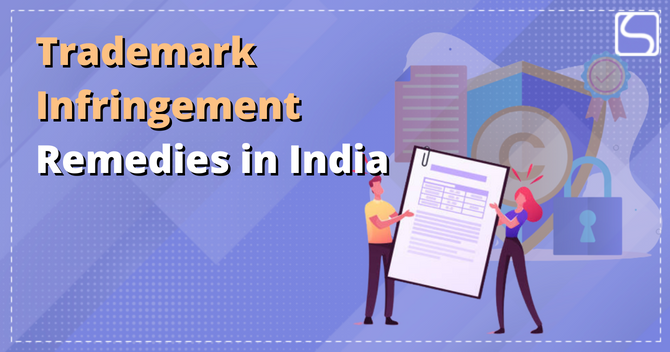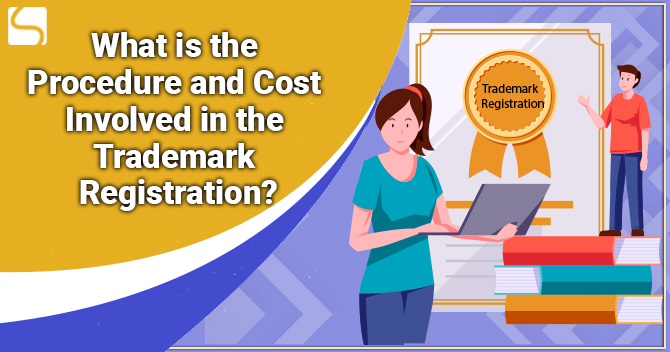Trademark Infringement Remedies in India

Ganesh Nair | Updated: Aug 31, 2022 | Category: Trademark
In India, trademark regulations are governed by the Trademarks Act 1999. Trademarks are a type of Intellectual property and hence need to be protected. A person will be infringing a trademark when he tries to make unauthorised use of any mark that is deceptively similar or identical to a registered trademark. In such issues, the similarity of the trademark is adjudged by the fact if an average man sees the brand, he might get confused regarding the actual brand of the goods and services.
Table of Contents
What are the Types of Trademark Infringement?
There are two types of Trademark infringement. These are direct infringement/ indirect infringement.
- Direct Infringement:
Section 29 states the conditions under which it can be said to have committed direct infringement. These are:
- Use of the Trademark by an unauthorised person:
This type of violation takes place when a person uses the trademark who is not permitted or not authorised to use the registered trade mark. If an authorised person uses the trademark, it won’t amount to infringement.
- When the mark is Identical or deceptive:
If an unauthorised person uses a mark that is identical/similar to an already registered trade mark, it shall be considered a trademark infringement. The Act specified the term “deceptively similar”, – which means that the mark should be so similar that it would be difficult for an average person to distinguish between the two brands. If the registered trade mark holder can prove that there is a scope of misrecognition, then the trademark shall be considered to be infringed.
- Registered Trademark:
The Trademark act secures the interest of registered trademark holders. The trademarks must be registered with the trademark registration of India. If the matter involves dealing with the breach of unregistered trademarks, then the courts shall give the decision based on the common law.
- Use of Goods and Services:
The trademark infringement is said to be committed if the unauthorised use of the trademark in question is used to provide goods and services under the same registered trademark category.
Indirect Infringement:
The Act does not deal with Indirect infringement. However, this does not mean that no –recourse can be provided in such cases. The trademarks’ infringement are universal and shall hold the violator liable and any person who abets or induces anyone to infringe. We can classify indirect infringement into two types these are:
- Vicarious liability: section 114 of the Act states that when a brand commits an offence, the entire company shall be held liable for the offence. So, along with the principal infringer, the entire company shall be liable for ‘Indirect Infringement’. During a vicarious liability, if the master (company) can control the actions of the employee (infringer), then it shall be deemed that the company themselves have made that infringement. However, a company shall not be held for vicarious liability of an infringement if the company acted in good faith and didn’t know about trademark infringement.
- Contributory infringement: contributory elements include three things
- The person must have knowledge about the infringement
- the person has contributed in some way to that infringement
- If the person induced someone to commit infringement.
Contributory infringement cannot claim the defence of good faith as a contributory infringer cannot act in good faith.
What acts shall be considered Trademark infringement in India?
- If the trade mark in question is deceptively similar or somewhat identical to a registered trademark that renders the same goods or services.
- Such similarity in the trademark will lead to confusion in the minds of the general public that the new mark is associated with the old mark.
- The trademark in question is part of the business’s name in relation to goods and services of which the trade mark is registered.
- If the trade mark through advertisement receives an unfair advantage and goes against the practice of good faith or is injurious to the reputation of the registered trademark.
- If any person uses the registered trademark for packaging and labelling of goods without the permission or proper authorisation from the registered trademark holder.
What are the acts that do not amount to Trade mark infringement in India?
Section 30 of the Act specifies that all acts don’t amount to trade mark infringement. These steps can also be used as a defence in trademark infringement cases. And in some cases, the liability of the infringer can be reduced.
- If the trade mark is being used to depict quality, quantity and the kind of goods and services:
If the infringed trademark is used to depict the quality, quantity or kind of goods and services. In a famous case involving two brands, Rich’s whip topping and Bell’s Whip topping, the court ruled against the trademark holder bells whip topping as the name “whip topping” indicated the type of goods and services the brand sold.
- No mark that is outside the scope of registration should be used:
If registered names contain words that are very common in day-to-day use, then the proprietor cannot claim the right of infringement against such names. For example, in the case of “ABC Daily market”,- in this case the words daily and market are commonly used phrases; hence Trademark infringement cannot be claimed against these words.
- Matters where there is an implied consent:
In some situations, it might happen that a proprietor uses a mark for certain goods and services that the registered user had applied for. In some situations, it even happens that the trade mark has not been removed, or the parties at a time, through express or implied consent, may have been given permission to use that trademark.
- Registered trade mark used for Accessories and parts:
If a registered trademark has segment relation to any goods, services, parts or accessories and if this is considered to be reasonably necessary, the effect of such would not be considered an infringement of the original trademark.
- If two registered trademarks are identical to each other:
Where two or more registered trademarks are similar to each, then each trade mark holder has the right to use their specific registered trademark, and this act won’t amount to infringement.
Remedies for trademark Infringement:
Two types of remedies shall be available to a proprietor in case of trademark infringement these are:
- Civil Remedies
- Criminal Remedies
- Civil Remedies:
Issuing Injunctions:
The injunction means when the court stops an individual from doing a particular activity. In case of trade mark infringement, the court shall stop the person from making unauthorised use of the trademark. Courts usually take this recourse when the proceedings are going on, and it is unclear whether the infringement has taken place or not. During this, the court may order a temporary injunction to halt any profit being made by the accused.
Awarding Damages:
Many times it happens that an individual has to suffer a lot of losses because of the wrongdoings of other in such cases, the court award compensation to the victim. This is known as awarding damages. So, when a person infringes the right of others, the court can also award damages. Mostly, the damages awarded are more than the loss suffered by the registered trademark holder.
Destruction & Sealing of the Goods:
When a trade mark is infringed, then in such cases, the court has the power to ask the local commissioner to go and seal the material of the infringed trade mark and accounts connected to them. The court even has the power to direct the police officers to destroy the infringing material. Or the infringed goods and products might be asked to be delivered to the court of law.
Restoration of reputation:
Lastly, in the matters of civil litigation, the courts can ask the infringer to take adequate steps to restore the proprietor/business/company’s reputation that was destroyed because of the infringer’s actions. The trade mark infringers in the past have apologised through advertisements or by giving a public statement to restore the customers’ faith in the company whose trade mark was infringed.
- Criminal Remedies
Trademark infringement is a cognisable offence under the Trademark Act, 1999, and an FIR can be filed against the infringer.
Imprisonment:
Section 103 of the Trademark Act state that anyone who is found to be guilty of trademark infringement shall be imprisoned for a period of six months which can be extended for a period of three years.
Fine:
Section 104 of the Trademark act state that a fine can be imposed on infringement cases. It states that a fine of ₹50,000 can be imposed on it, which can be extended up to ₹2, 00,000.
Fine for continual/subsequent offences:
If a person is found to be a repeated violator under sections 103 & 104, then he shall be liable to an enhanced penalty as per section 105 of the Trademarks Act 1999[1].
Seizure of power:
A court can order the seizure of power of the infringer so that the abovementioned provisions can be carried out smoothly. However, this procedure must be carried out by the law as per the provisions laid down by the law.
Conclusion:
Trademark Act regulates trade mark laws in India. It also has provisions for the trademark infringement specified in it. The trade mark infringement laws have been clearly defined, specifying what acts amount to trademark infringement and what shall not. Additionally, various recourse is available to the registered trademark holder whose mark has been infringed. The aggrieved person has an option to have remedies in both civil and criminal forms














